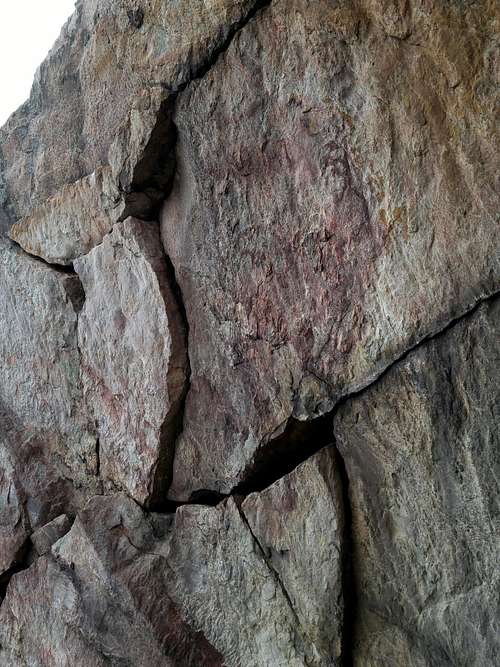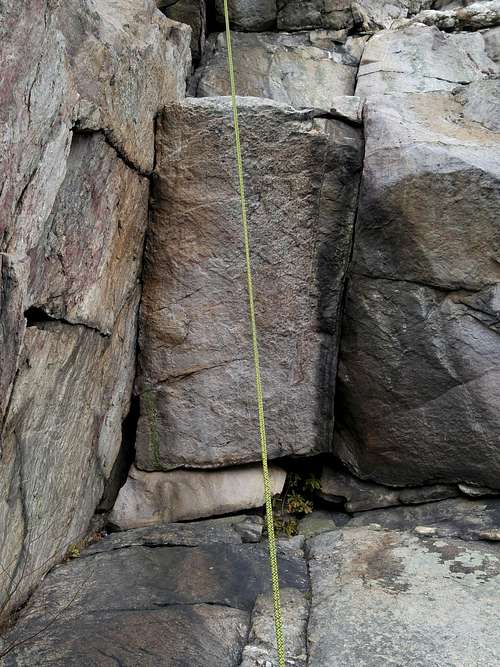-
 1690 Hits
1690 Hits
-
 72.08% Score
72.08% Score
-
 2 Votes
2 Votes
|
|
Mountain/Rock |
|---|---|
|
|
39.26264°N / 77.39412°W |
|
|
Trad Climbing, Toprope |
|
|
Spring, Summer, Fall, Winter |
|
|
1280 ft / 390 m |
|
|
Overview
At Sugarloaf Mountain, Boy Scout Ledges and Middle Earth get most of the attention because of easy access (next to a maintained trail or very close to it) and a concentration of moderate routes, but there are four other nice climbing spots on the mountain. Upper West View is one of them. There are only six established routes there, ranging from 5.5 to 5.11, but the crag offers a break from other climbers and the typical weekend hiking hordes (consisting of large numbers of non-hikers out for a hike, if you catch my drift) in a scenic location. Note-- since most people toprope the routes here, you will get to mingle with said hordes as you build anchors and/or top out.Because the cliffs face southwest and have little shade, they get great winter sun. On two occasions during February 2016, I climbed here when temperatures were in the 40s and was very comfortable.
As I mentioned already, these are toprope routes here, but most could be led. However, to keep with the prevalent usage here, I will present the routes as TR ones since that has been my only experience with them as well.
Getting There
From I-270 in Maryland, take Exit 22 onto MD 109 and head west. In about three miles, turn right onto Comus Road. In a few minutes, you will reach the entrance to Sugarloaf. Follow the one-way road up the mountain and park in the West View lot. Take the Green Trail from the right end of the parking lot (this is the trail accessing Boy Scout Ledges and Middle Earth). Pass ME and BSL and then reach the wooded summit. From there, head down a bit to a rocky overlook. Unfortunately, vandals have painted on the rocks here, but that actually helps in locating the anchor positions. Look for two blue-painted foot outlines; they actually mark the spot for the anchor for the first four climbs listed in the next section. To set an anchor for the other two, go a few yards as you look out from the overlook.Rappel down or find one of a few roundabout scrambling options to get to the base.
There is also an approach from the west via U.S. 15 and MD 28. From 28, take a left onto Mouth of Monocacy (easy to miss, but another turn comes up shortly after). At a stop sign, turn left and eventually reach an intersection directly across from the park entrance.
There is also an approach from the west via U.S. 15 and MD 28. From 28, take a left onto Mouth of Monocacy (easy to miss, but another turn comes up shortly after). At a stop sign, turn left and eventually reach an intersection directly across from the park entrance.
Routes
The routes here are fun; setting anchors for them is not.
One factor is that unless you have lots of webbing and/or static line so that you can sling trees way back from the edge, you have to build gear anchors.
The other factor is people. On some occasions, I have seen dozens of people clustered around the topout area. No one has intentionally messed with my gear or lines, but I feel really uneasy with so many casual visitors about what is there to protect my life. Thus, although it's more of a pain than slinging trees (and scarier to trust), building anchors using stoppers and hexes close to the edge is the better way to go.
Off the first anchor, you can do four routes. All except the fourth begin on a prominent crack/flake. The first two times I climbed routes here, I had a tougher time than expected with this flake and was questioning whether it really was as easy as 5.5. Then I figured it out-- if you layback it, it is quite easy. From left to right:
- General Hong's Army (5.5)-- Above the crack, mantle up onto a ledge and approach two roofs. Climb up left of the roofs. Stemming by using the adjacent wall helps.
- La Cucharita (5.7)-- Above the crack, mantle up and then pull the roof on the right (the left is notably harder). If you're tall, you can reach a great hold above and right and the pull is pretty easy and fun. Otherwise, you're going to have to work for that hold, and the route will probably feel harder than the rating.
- Torque Around (5.8)-- Above the crack, mantle up and traverse right beneath the roofs and then climb a large, steep crack. Like most 5.8 routes at Sugarloaf, this is more musclely than technical.
- Torqued Off (5.10c)-- Continue up the ramp past the crack and to the crack in the overhanging corner on the left. Climb that corner and then finish as per Torque Around. The holds are all there, but unless you're solid at the grade, and this particular style of climb (I'm pretty decent toproping on 10c slab but not on an overhanging 10c), you're going to take big swings if you come off, and that made it tough for me doing this on solo TR, so I eventually swung myself to the other crack and did Torque Around. Even if you are solid at the grade, I don't recommend doing this solo because if you do swing, it's a real pain getting back on the route.
The two routes done off the other anchor (I have not climbed either):
- Ino Yormos (5.11+)-- This goes up the crack to the right of the Torqued Off crack. Some commenters on Mountain Project think this is 5.12 material.
- Mr. Hutt's TP (5.7+)-- A supposedly very technical 7 that starts up the crack farthest right and has an overhang pull at the end.
If you're topping out rather than just tagging anchors and lowering, know that the topouts on all the routes are steep, even slightly overhanging on some, but that the holds are all there.
Source for route names and basic info about them: Mountain Project page. I've climbed the routes in bold on TR both solo and with a belayer.



